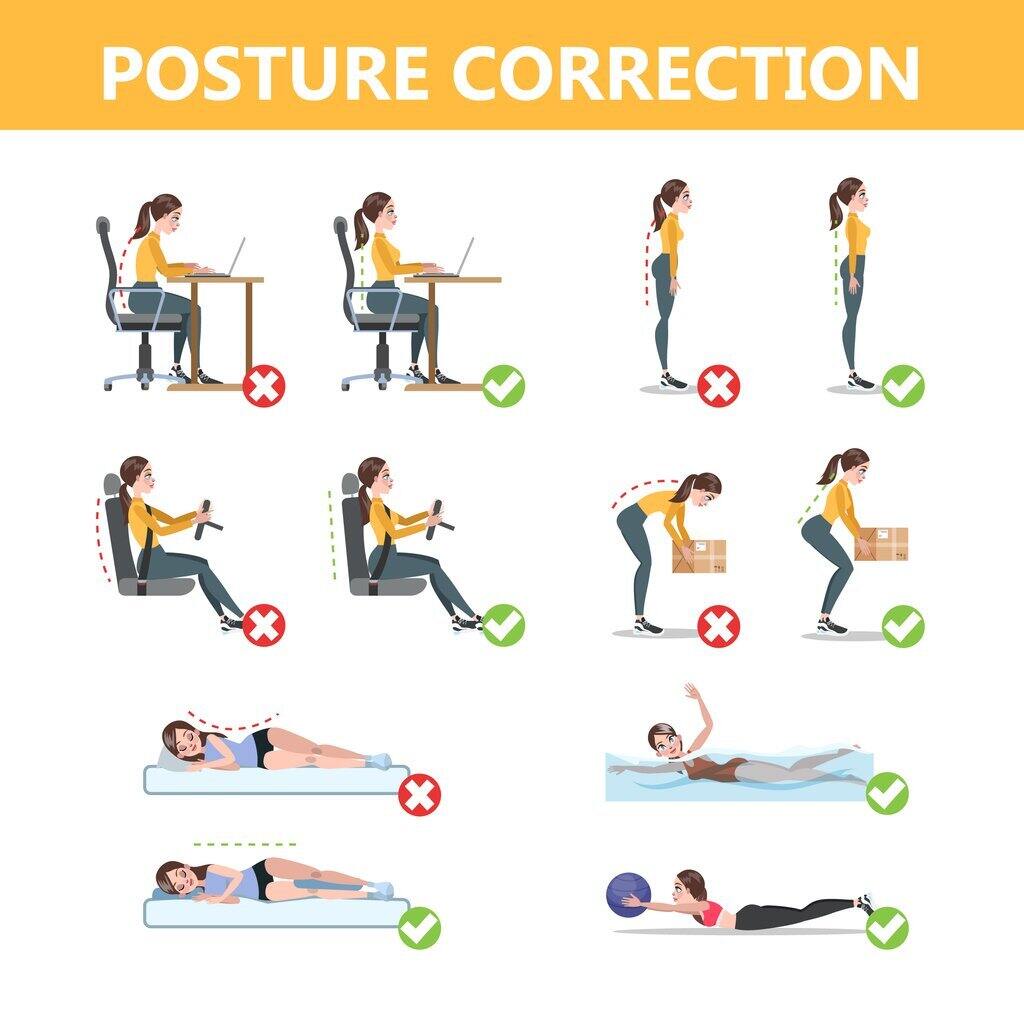Transform Your Stance: 7 Exercises to Improve Posture Fast
Do you find yourself slouching at your desk or hunching over your phone all day? Poor posture not only affects how you look but can also lead to neck and back pain. The good news is that with some simple exercises to improve posture, you can transform your stance and feel better in no time.
Understanding Posture and Its Importance

Posture, simply put, is the foundation upon which your body’s balance and alignment rest. It is the positioning of body parts in relation to each other and their orientation in space. When aligned properly, your body can move with greater efficiency and less strain on your muscles, ligaments, and joints. A healthy posture supports bodily functions such as breathing and digestion and is critical for preventing fatigue.
Moreover, posture is not just about standing tall; it influences how you sit, walk, and even sleep. It plays a pivotal role in your overall health and well-being, impacting not only physical aspects but also how you feel and present yourself to the world. Good posture boosts confidence and projects a positive image.
Unfortunately, the modern lifestyle, characterized by prolonged periods of sitting and screen time, has led to a widespread neglect of proper posture. This neglect can lead to a range of issues, including chronic pain in the neck, shoulders, and back. It can also contribute to decreased flexibility, impaired organ function, and an increased risk of injury during physical activity.
Recognizing the critical role of posture is the first step towards correcting it. By understanding its importance, you are better equipped to take proactive measures, such as engaging in exercises to improve posture, to enhance your overall health and quality of life. This foundation of knowledge sets the stage for the transformative journey towards achieving and maintaining optimal posture.
The Foundation: Core Strengthening Exercises

At the heart of posture correction lies the core—the central powerhouse of your body. Engaging and strengthening the core muscles is not just about achieving a flat stomach; it plays a pivotal role in stabilizing your spine, keeping you upright, and maintaining an aligned posture throughout the day. The inclusion of core exercises to improve posture is a vital component of any posture correction strategy.
Beginning with planks, this exercise demands engagement from the entire core, challenging your stability and endurance. Planks can be modified for different fitness levels, making them accessible to everyone. Next, crunches offer targeted engagement of the abdominal muscles, while leg raises effectively work the lower abdominals and hip flexors, areas often neglected in daily activities.
To incorporate these exercises effectively, focus on form and mindful engagement of the core muscles. It’s not about the quantity of repetitions, but the quality of each movement, ensuring that you’re not just going through the motions but actively strengthening your core. These exercises lay the groundwork for a stronger, more stable core, which in turn supports a better posture. As you integrate these core strengthening exercises into your routine, you’ll find your spine supported more naturally and your posture effortlessly improved.
Shoulder Openers and Strengtheners

To effectively enhance your posture, incorporating shoulder openers and strengtheners into your exercise regimen is crucial. These types of exercises are designed to combat the common issue of rounded shoulders, a result of prolonged periods of sitting or looking down at electronic devices. By focusing on exercises that open up and strengthen the chest and shoulders, you can work towards achieving a more balanced and upright posture.
One beneficial exercise is the doorway stretch, which utilizes a standard doorway to gently stretch the chest muscles, encouraging the shoulders to roll back into their natural alignment. Another important movement is the reverse dumbbell fly. This exercise targets the rear deltoids and the muscles between the shoulder blades, key areas for pulling the shoulders back and down, away from the ears.
Incorporating band pull-aparts is another effective way to strengthen the shoulder area. This exercise involves using a resistance band to perform outward pulls, engaging and strengthening the muscles across the upper back and shoulders. Additionally, the face pull exercise can be performed with a resistance band or a cable machine and is excellent for directly targeting posture-critical muscles, promoting shoulder health and stability.
These exercises, when performed regularly, not only work towards correcting rounded shoulders but also significantly contribute to overall posture improvement. Engaging in these movements encourages the body to adopt a more open, upright stance, facilitating ease in everyday activities and reducing the likelihood of posture-related discomfort.
Back Strengthening Moves for Posture Correction

For a robust approach to improving posture, incorporating back-strengthening exercises is indispensable. These activities target the muscles that are crucial for supporting an upright position and mitigating the adverse effects of prolonged sitting. A prime exercise for this purpose is the row, which can be performed with dumbbells, a barbell, or a resistance band. Rows focus on the upper and middle back muscles, fortifying the spine’s support system.
Another effective move is the Superman pose, an exercise that extends the entire body while lying face down, activating the lower back muscles along with the glutes and hamstrings. This movement simulates the flying posture of its namesake superhero, enhancing back strength and endurance.
Bird dogs offer a dynamic exercise option, engaging the core and back simultaneously. This exercise involves extending one arm and the opposite leg while maintaining balance on all fours, highlighting coordination and spinal stability.
Integrating these exercises into your workout routine strengthens the back muscles, essential for a straight, healthy posture. They address the core issues contributing to poor posture, such as muscle weakness and imbalance, providing a solid foundation for posture correction. Engaging in these back-strengthening moves regularly will aid in developing a stronger, more aligned posture, supporting your overall well-being and physical health.
Neck and Upper Back Stretches

Tight muscles in the neck and upper back are often culprits behind compromised posture, contributing significantly to discomfort and misalignment. Engaging in regular stretching exercises targeted at these areas can be transformative, offering relief and aiding in the correction of posture. Start with gentle neck rolls, which encourage flexibility and release tension accumulated from hours of stationary positions, such as sitting at a desk. Shoulder shrugs and circles are excellent for loosening the trapezius muscles, which bear much of the tension from daily stress and poor ergonomic setups.
To address the upper back, a simple yet effective stretch involves clasping your hands behind your head and gently pulling your elbows back to open up the chest. This counteracts the forward hunch and encourages a natural, upright posture. The cat-cow stretch, a fundamental yoga move, also benefits the neck and upper back by promoting spinal flexibility and relieving tension through its fluid motion.
Incorporating these stretches into your daily routine not only targets key areas prone to stiffness and pain but also supports a more aligned and healthy posture, making them indispensable tools in your posture correction toolkit.
Incorporating Balance and Flexibility Work

Enhancing your posture goes beyond strengthening muscles; it’s also about fostering greater balance and flexibility throughout your body. Engaging in activities that challenge these aspects can lead to significant improvements in how you hold yourself day-to-day. Yoga, for instance, offers a comprehensive way to achieve this, combining poses that build strength with those that improve flexibility and balance. Pilates is another excellent choice, emphasizing core strength, flexibility, and mindful movement, which together can positively impact posture.
Additionally, incorporating simple balance exercises, like standing on one leg or using a balance board, can train your body to maintain proper posture without conscious effort. These exercises, coupled with regular stretching routines, not only enhance your body’s overall alignment but also contribute to a smoother, more coordinated movement in everyday activities.
By dedicating time to develop these components, you’re taking a holistic approach to posture improvement, paving the way for a healthier spine and a more confident stance in your daily life.
Putting It All Together: A Daily Posture Correction Routine

Embarking on a journey to correct your posture requires dedication and a strategic approach. Establishing a daily routine that encompasses the key exercises outlined earlier is critical. Aim for a dedicated 10-15 minute session each day, focusing on a mix of strengthening and stretching exercises targeting the core, back, shoulders, and neck. Begin with core exercises to build a stable foundation, then move on to shoulder and back exercises to address alignment and strength. Don’t forget to include stretches for the neck and upper back to alleviate tension and improve flexibility.
Incorporating balance and flexibility exercises, such as yoga or Pilates, can also enhance your posture by teaching your body to naturally maintain alignment. By adhering to this daily regimen, you’re not only working towards correcting your posture but also investing in a future of reduced pain, increased confidence, and overall well-being. Remember, consistency is key; stay committed to your routine, and the results will follow.



